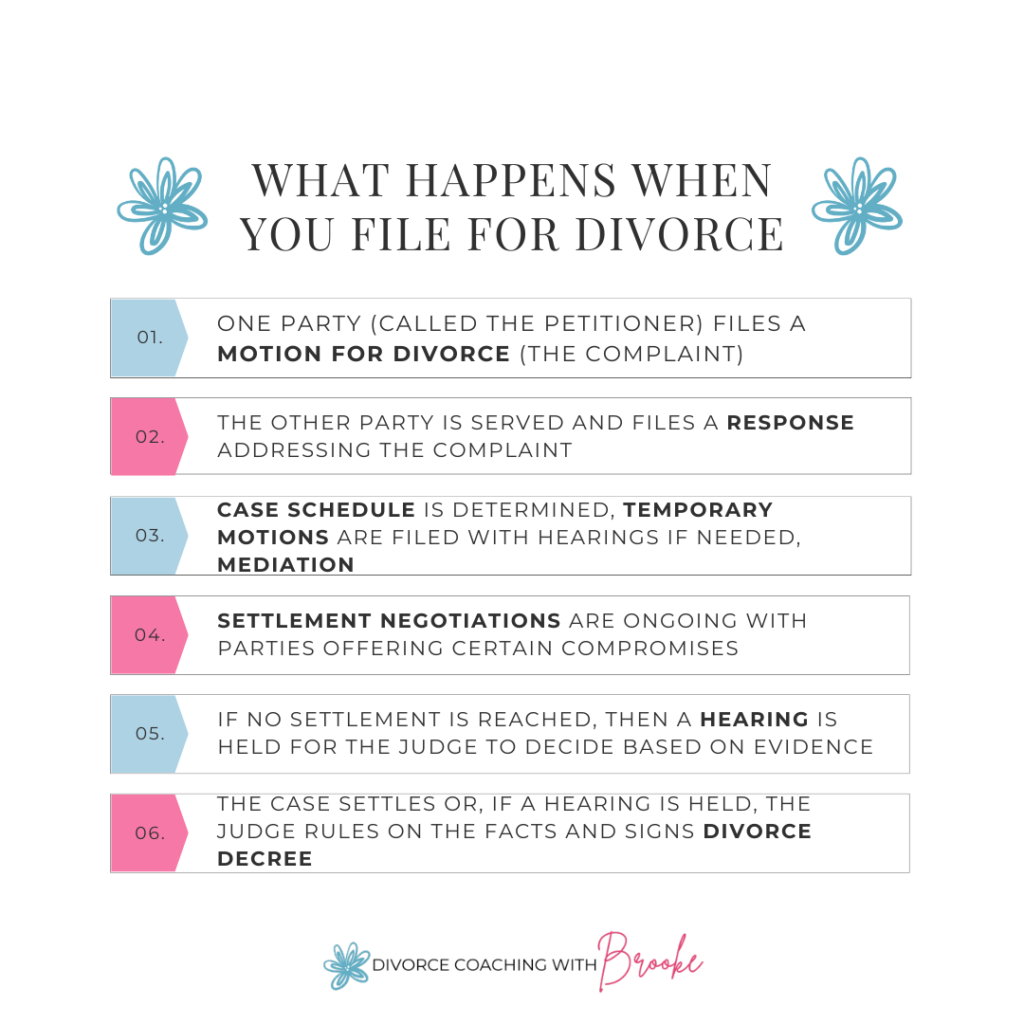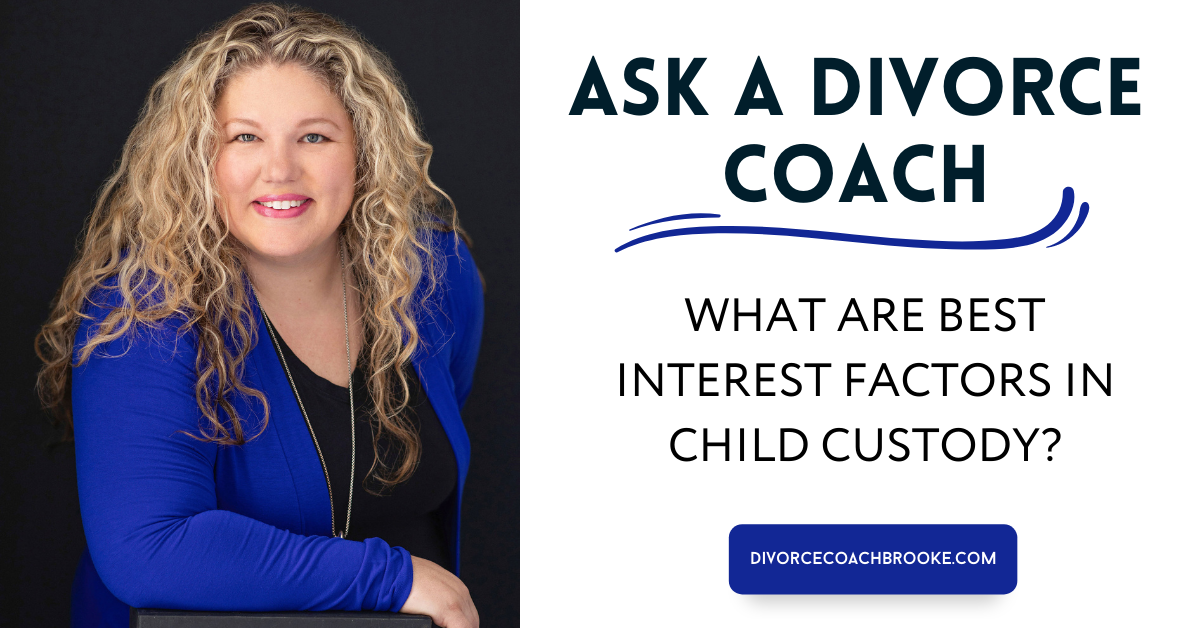
What are the steps for filing for divorce?
Everything I knew about divorce I learned on bad TV! That’s mostly true. I also knew about divorce having grown up in a home with divorced parents. I lived with my mom in the school year and my adopted dad in the summer. Divorce is so much more complicated than that, especially if you are married to someone with a high conflict personality.
After I asked for my divorce, I walked into an attorney’s office thinking that they would tell me what to do. Instead, they waited for me to tell them. But I knew NOTHING about how the system worked. I was relying on the attorney to tell me how to proceed. And honestly, I thought I would share the timeline of abuse, manipulation, and threats, and he would rush into action to protect me and the kids.
Instead, he told me that I needed to “give X a chance to be a dad.” What?! I had given him a chance to be a dad. He sucked at it. And then he had threatened to kill me. Surely, we weren’t going to send the kids off unsupervised with this unstable person.
But that’s what happened. That’s what the courts told me was normal. That is the system we have created.
So for those new to divorce or considering separation and divorce, here is a little primer on how the process goes. Disclaimer: I am not a lawyer. I am a protective mom who has walked through the process and helps other protective moms. Questions about the specifics of your legal case should be run through your attorney.
 What happens after I say I want a divorce?
What happens after I say I want a divorce?
After you tell your partner that you want a divorce (or after they tell you they want a divorce), one party typically moves out of the marital home. This has changed some in the last several years with both parties continuing to live together. In high conflict cases where there is alleged abuse, this is probably not the best option for your mental health, but I understand why some people do this. If you have filed an order of protection, the terms of the separation and contact will be a little different and will be addressed in another post.
There are several ways to go through the divorce:
- With an attorney – This is a pretty standard route. One or both parties hire an attorney who are able to file motions and requests for orders on your behalf. You can also have an attorney draft an agreement that you both end up signing and filing with the court (this is what I did, but X is unique in not fighting for custody initially).
- Through a collaborative divorce – If you are on good terms with your partner, there are options for collaborative divorces where you work together to create an agreement. This is not typically possible with the clients I work with.
- Mediation – You can also hire a mediator to help you come to an agreement that you file with the court. As with collaborative divorces, this is difficult for clients who have personality disordered or abusive spouses.
In some states (Virginia for example), parties are required to be separated for a year prior to filing for divorce (yay antiquated laws that force moral judgement and marriage on people). If you have an abusive partner, this year can be full of love bombing to try to get you to reconsider. It is important for you to educate yourself on controlling behaviors and the abuse cycle in order to protect yourself during this time!
Depending on how your partner views this process as well as their desire to create chaos and conflict, even getting a separation agreement can be challenging. But, if you can get one, it can lay out a plan for temporary custody while the divorce is ongoing as well as define living arrangements, financial obligations, and debt. Anything that may be addressed in the final court order for the divorce can basically be addressed in the separation agreement (and then later, the parties can use that agreement as the basis for the divorce, again depending on the parties’ states of mind).
The legal divorce process
So, you’ve decided to divorce. One of you has moved out. You’ve consulted an attorney. Now what?
Filing for Divorce
Your attorney will draft a complaint essentially that lays out the facts that are relevant for the divorce. Things that might be included in the filing:
- Finances
- Current living situation
- Length of marriage
- Names, DOB of children
- Assets, including homes
- Debts, including cars and credit cards
- Date of separation
- Circumstances around the reason for the separation depending on how the state views divorce and whether it’s a no-fault state
- Allegations of abuse
The complaint will also ask for relief. This is where you need to be specific with your attorney about what you want. Even if it is a default 50/50 state, you can ask for something else and tell your attorney to fight for that arrangement. No, you might not get it, but you are the client and can tell your attorney what matters to you. Relief might include:
- Custodial time
- Holiday visits
- Legal custody (please ask for tie breaking decision authority on educational and medical decisions)
- School placement
- Health insurance
- Debt responsibility
- Asset allocation
- Alimony
- Child Support
If there is no separation agreement and no stipulated agreement – an agreement both parties agree to and file with the court, then one party can file for temporary custody orders. If there is a belief that the child(ren) are at risk, you can file for an emergency custody hearing, but you must be able to show that there is the possibility of harm. If you believe your children are in harm but your attorney is shrugging, remember that you are the client and can tell your attorney to file an emergency motion. Again, it might get denied, but it won’t be you sending your child into harm’s way. The court can’t later blame you for the visit (not that the court will take responsibility either).
Temporary custody orders are specific to custody and set out the terms of custody and visitation while other matters and the divorce are being decided. You will have a hearing on the motion that is filed (that will again contain facts supporting the desired relief and the custody schedule you believe is best for your children). This hearing will be much shorter than the eventual divorce, but you will likely still present some evidence about why you are asking for less than 50/50. Many times, these requests for temporary orders also include an affidavit, declaration, or certification. My affidavits often were a couple of pages long and read something like:
- I am the mother of CHILD 1 and CHILD 2.
- Our current custody schedule provides for once a month overnight visits to be scheduled by X with seven days notice.
- Since our separation on DATE, X had not taken any of his provided overnights.
- On DATE, a year later, X asked for his first overnight.
- At the exchange for that overnight, CHILD 2 expressed concern over the visit and then vomited in the parking lot.
For this example, I would have asked for overnights to be suspended until a final hearing. In the affidavit, you only want to include facts, not emotions.
In most cases, a judge will order both parties to mediation. They do not want to hear these cases and believe that everyone is sane and healthy and should be able to come to an agreement. Obviously, we know that isn’t true. But, they will send you off to a mediator anyway to try to get you to some agreement. Usually, this means that the victim of abuse gives in to the demands of an abuser or ends in mediation breakdown. But, you *can* negotiate with a narcissist, no matter what anyone tells you.
Scheduling and Status Hearings
After you have filed for divorce, the other party will have a chance to answer that claim. Then the judge will hold a scheduling conference with both attorneys (or representatives from both sides). They will schedule the final hearing as well as deadlines and status hearings along the way. The status hearing can be an update after mediation or can be closer to the actual hearing once the attorneys have submitted their theories of the case. A lot of these hearings are again intended to get you to settle.
You will be asked to provide evidence in the form of discovery for your claims in the complaint that is filed. Evidence can be text, photos, emails, therapy notes, report cards, medical notes, audio files etc. This has to be provided to the other party. They will also send you a list of items that they want you to provide, which can include emails, texts to other people (including your friends and parents), social media posts, etc. You will also help your attorney come up with a list of items to request from your ex that you want to look through that you think will help build your case. Remember, anything in writing that isn’t communication with your attorney can be discoverable. You will also send a list of questions – and be sent a list of questions – to answer for the other side.
Depositions
Depositions are often scheduled as a way to get additional information from the other side prior to court. During a deposition, you are sworn in just like you would be in court. Transcripts from the depositions can then be entered into evidence during the hearing.
The hearing
You will finally have a hearing after what feels like 17,000 years. This is when you will present your evidence. You will likely be called to testify as will your ex. You will be cross examined by the other side, who will likely not treat you nicely. You would also call any witnesses, forensic accountants, forensic psychologists, or expert witnesses to bolster your case.
Final Order/Divorce Decree
After your hearing, the judge will likely issue a document called “Facts and Findings” where they assert what is true about your case. This document can be enraging if you know that your ex lied, and your judge writes it as truth in the facts and findings, which is an official court record. My judge called me controlling for asking X to adhere to the court order and to use bug spray when he is very allergic to mosquitoes. It’s been years, and I still won’t read the entire document!
The final order will spell out the details of your divorce, but more specifically, the details regarding custody. This will become your guiding document and the rules that you live under for better or worse until the kid ages out of the system or you file for a modification.
Learn More

My ex was abusive. He won’t get custody. Right?!
 This has been one of those weeks where the reality of family court slams headfirst into logic and common sense. I’ve had a couple of conversations with mothers who believe that the evidence they have of domestic violence and abuse will be enough to protect their children and ensure they have primary custody.
This has been one of those weeks where the reality of family court slams headfirst into logic and common sense. I’ve had a couple of conversations with mothers who believe that the evidence they have of domestic violence and abuse will be enough to protect their children and ensure they have primary custody.
Those of us who have lived in this system will tell you that is not what we see happen day in and day out (that’s not to say that *some* people aren’t able to protect their children). The Leadership Council on Child Abuse and Interpersonal Violence found that “more than 58,000 children a year are ordered into unsupervised contact with physically or sexually abusive parents following divorce in the United States.”
Reality #1: Domestic Violence is only one factor in determining the best interest of the child in divorce.
And it is not necessarily weighted any higher than the other factors. One of the other considerations is the ability to maintain a relationship with (and even speak highly of) the person who abused – or even threatened to kill – you. As I’ve shared elsewhere, my ex husband threatened to strangle me. And I was still admonished by the court for not liking him. The court seemed to take the approach that my not liking him would cause me to make up the story about the strangulation instead of the more logical explanation that his behavior caused me to have deep fear and discomfort around him.
Reality #2: Parental Alienation has a stronghold on the family law system.
It feels to many of us in the domestic violence system that the courts would rather believe that a mother was making things up than believe the harder truth that a parent would sexually abuse their child. The minute a protective mother goes to the police or the court to get a domestic violence protection order, she is suspect of parental alienation. I will say that again: If you need help leaving a domestic violence situation because your ex might kill you, YOU (the victim) become an immediate suspect in family court.
Reality #3: Gender Bias is real.
Joan Meier at the GW Family Violence Law Center published a study in 2019 entitled “Mapping Gender: Shedding Empirical Light on Family Courts’ Treatment of Cases Involving Abuse and Alienation.” The study analyzed over 4,000 custody cases in the United States to examine how family courts handle cases involving allegations of domestic violence and parental alienation. The study found that gender bias may play a role in how courts handle custody cases. Specifically, when fathers raised allegations of alienation, they were more likely to receive custody than mothers who made similar allegations. Additionally, when mothers raised allegations of abuse, they were more likely to lose custody than fathers who were accused of abuse.
Reality #4: Lawyers.
In my experience, family court lawyers often dismiss domestic violence claims. Many of them believe in parental alienation – in part because it’s an effective strategy for their male clients. One family law attorney I saw with multiple pages of my children’s allegations told me that we really didn’t know what was happening at my ex’s house with the kids because if we did, we wouldn’t be there (trying to fight for custody). This said to me that if the court believed me and my children there was no way they would allow him unsupervised contact. But the courts just didn’t believe me. Thousands of other protective mothers have discovered similar.
Reality #5: There is a presumption that having both parents in a child’s life is in their best interest.
Some states have gone so far as to create a presumptive 50/50 custody statute. Any parent who believes that 50/50 is not in the best interest of a child then has the burden of proof on them to prove why not. This becomes even more challenging because of the laws of evidence. In my case, my ex’s attorney filed a motion requiring strict adherence to the rules of evidence, meaning that any declarations my children made were considered hearsay and inadmissible. The court wouldn’t interview them either, so their voices and stories were ignored, and my concerns were dismissed.
—
This sounds dismal, and in some ways it is. But it’s also not hopeless. There are advocacy efforts underway in many states to change and amend the family law statutes to give domestic violence claims greater weight in custodial decisions by family court judges (including Kayden’s Law). There is a growing body of research about gender bias and abuse claims in the courts. And there are those of use who have lived experience in the courts not only speaking out about it but also helping others who are coming behind. I was ultimately able to protect my children. That alone gives me hope that others can too.
Learn More
What are Best Interest Factors in child custody?
When courts determine child custody, they use the best interest of the child standard, which considers several important factors to ensure the child’s overall well-being is prioritized. These factors help guide decisions about where the child should live, how much time they will spend with each parent, and who will be responsible for making key decisions in the child’s life. While each case is unique, the following are some of the most commonly used best interest factors that courts consider when determining custody.
What are the best interest factors?
The best interest factors in child custody vary depending the jurisdiction (or location) where the custody dispute is taking place. Each state has its own set of laws regarding custody, and those can generally be found by googling “best interest factors in child custody in [put your state here].” However, there are several common factors that are generally considered by courts when making custody determinations. These include:
-
The child’s age, gender, and developmental stage
The child’s age, gender, and developmental stage play a key role in determining their needs and the type of care required. For example, an infant may need more frequent interaction with the primary caregiver, while an older child may benefit from maintaining strong ties with both parents. Developmental needs can also influence decisions regarding schooling, healthcare, and emotional support. Courts consider how well each parent understands and can meet the child’s needs based on their developmental stage.
-
The child’s relationship with each parent and other important people in their life, such as siblings, grandparents, and extended family members
Courts assess the child’s relationship with each parent and other key individuals in their life, such as siblings, grandparents, and extended family members. A positive, healthy bond with each parent is crucial, as is maintaining strong connections with siblings and other important people. Judges aim to create a custody arrangement that preserves these important relationships, recognizing the emotional and social support they provide to the child. Courts may also take into account the consistency of these relationships over time and how involved each parent has been in the child’s daily life.
-
Each parent’s ability to provide for the child’s physical, emotional, and educational needs
Each parent’s ability to meet the child’s physical, emotional, and educational needs is central to determining the best custody arrangement. This includes providing essentials like food, shelter, and healthcare, as well as emotional support and guidance. Courts will evaluate how each parent can support the child’s education, whether that means helping with schoolwork, attending parent-teacher meetings, or ensuring the child participates in extracurricular activities. The ability to create a nurturing and secure environment that fosters emotional well-being is crucial in these decisions.
-
Each parent’s mental and physical health
A parent’s mental and physical health can significantly impact their ability to care for the child. Courts assess whether a parent is physically and emotionally capable of meeting the child’s needs. If a parent has a mental or physical health condition that affects their ability to provide consistent care, this could influence the custody arrangement. However, courts are also mindful not to discriminate based solely on a diagnosis; they focus instead on how the condition affects the parent’s ability to parent effectively.
-
The child’s preference, if the child is mature enough to express one
In some cases, courts will consider the child’s preference regarding where they want to live, provided the child is mature enough to express a reasoned opinion. The weight given to the child’s preference depends on their age and emotional maturity. While the court considers the child’s input, it ultimately balances their wishes with other factors to ensure the decision is in the child’s best interest.
-
The ability of each parent to provide a stable and consistent home environment for the child
A stable and consistent home environment is essential for a child’s well-being. Courts look at each parent’s ability to offer stability, including a safe living situation, a routine that supports the child’s development, and consistency in caregiving. Stability is particularly important for younger children, who need a structured environment to thrive. Courts may favor the parent who can maintain a stable household, especially if the other parent’s situation is more transient or unpredictable.
-
Each parent’s willingness to encourage and support the child’s relationship with the other parent
A parent’s willingness to encourage and support the child’s relationship with the other parent is a key factor in custody decisions. Courts prefer to grant custody to a parent who fosters healthy co-parenting and ensures that the child has a strong relationship with both parents. If one parent actively discourages or undermines the child’s relationship with the other parent, this behavior could negatively impact their custody outcome. Courts value cooperation and the ability to prioritize the child’s needs over personal conflict. *See Additional Comments below*
-
Any history of domestic violence, substance abuse, or other issues that could impact the child’s safety and well-being.
Finally, the court will carefully consider any history of domestic violence, substance abuse, or other issues that could impact the child’s safety and well-being. If a parent has a history of abuse, substance addiction, or other dangerous behaviors, the court may limit or supervise their custody or visitation rights to protect the child.
These factors are given different weights depending on the state and circumstances. However, it’s really important to understand the best interest factors before developing a parenting plan. It’s also really important as you look at your ongoing relationship with your ex-partner. Domestic violence is A factor in many jurisdictions. But it is not the only factor. (I would argue as would most of my colleagues that it should be the MOST IMPORTANT factor in custody decisions, but it often is not. Abusive parents get court-ordered, unsupervised custody and visitation every single day.)
* Willingness to encourage and support the child’s relationship with the other parent
The willingness of each parent to support the children’s relationship with the other parent is debated and contested in domestic violence spaces. But it is on the books in many places. What this means is that even if a parent threatened to kill the other parent – even if a parent threatened to kill the child – the other parent is theoretically supposed to encourage and support the child’s relationship with the person they consider dangerous. Not doing so can be labeled as “parental alienation” and can jeopardize a protective parent’s entire case. (There are certainly examples of judges recognizing the danger of domestic violence and protecting kids in these cases. It is very important to talk to your attorney about this, and you should ask specifically how to navigate your concerns while also meeting the willingness to encourage relationship best interest factor.)
The complexity of the best interest factors is one of the reasons why communicating with a disordered ex-partner is such an important strategic part of your post-divorce plan. In my case, the judge decided that I didn’t like X (I didn’t – for good reason), but the fact that she could tell hurt my case for several years. I know better now!
A divorce coach can help you locate resources to better educate yourself on your state’s best interest factors so that you can be strategically-minded during your ongoing custody battle.
Learn More